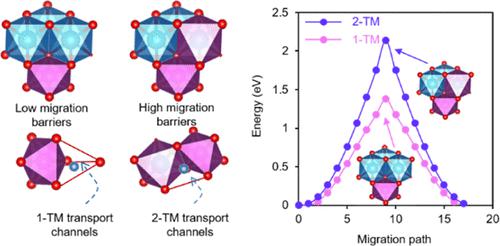当前位置:
X-MOL 学术
›
J. Am. Chem. Soc.
›
论文详情
Our official English website, www.x-mol.net, welcomes your
feedback! (Note: you will need to create a separate account there.)
Topotactic Transformation of Surface Structure Enabling Direct Regeneration of Spent Lithium-Ion Battery Cathodes
Journal of the American Chemical Society ( IF 14.4 ) Pub Date : 2023-03-06 , DOI: 10.1021/jacs.2c13151 Kai Jia 1, 2 , Junxiong Wang 1, 2 , Zhaofeng Zhuang 1 , Zhihong Piao 1 , Mengtian Zhang 1 , Zheng Liang 2 , Guanjun Ji 1, 2 , Jun Ma 1 , Haocheng Ji 1 , Wenjiao Yao 3 , Guangmin Zhou 1 , Hui-Ming Cheng 4, 5
Journal of the American Chemical Society ( IF 14.4 ) Pub Date : 2023-03-06 , DOI: 10.1021/jacs.2c13151 Kai Jia 1, 2 , Junxiong Wang 1, 2 , Zhaofeng Zhuang 1 , Zhihong Piao 1 , Mengtian Zhang 1 , Zheng Liang 2 , Guanjun Ji 1, 2 , Jun Ma 1 , Haocheng Ji 1 , Wenjiao Yao 3 , Guangmin Zhou 1 , Hui-Ming Cheng 4, 5
Affiliation

|
Recycling spent lithium-ion batteries (LIBs) has become an urgent task to address the issues of resource shortage and potential environmental pollution. However, direct recycling of the spent LiNi0.5Co0.2Mn0.3O2 (NCM523) cathode is challenging because the strong electrostatic repulsion from a transition metal octahedron in the lithium layer provided by the rock salt/spinel phase that is formed on the surface of the cycled cathode severely disrupts Li+ transport, which restrains lithium replenishment during regeneration, resulting in the regenerated cathode with inferior capacity and cycling performance. Here, we propose the topotactic transformation of the stable rock salt/spinel phase into Ni0.5Co0.2Mn0.3(OH)2 and then back to the NCM523 cathode. As a result, a topotactic relithiation reaction with low migration barriers occurs with facile Li+ transport in a channel (from one octahedral site to another, passing through a tetrahedral intermediate) with weakened electrostatic repulsion, which greatly improves lithium replenishment during regeneration. In addition, the proposed method can be extended to repair spent NCM523 black mass, spent LiNi0.6Co0.2Mn0.2O2, and spent LiCoO2 cathodes, whose electrochemical performance after regeneration is comparable to that of the commercial pristine cathodes. This work demonstrates a fast topotactic relithiation process during regeneration by modifying Li+ transport channels, providing a unique perspective on the regeneration of spent LIB cathodes.
中文翻译:

表面结构的拓扑转化使废锂离子电池阴极能够直接再生
回收废旧锂离子电池(LIBs)已成为解决资源短缺和潜在环境污染问题的紧迫任务。然而,直接回收用过的 LiNi 0.5 Co 0.2 Mn 0.3 O 2 (NCM523) 正极具有挑战性,因为锂层中的过渡金属八面体具有强烈的静电排斥力,该八面体由锂层表面形成的岩盐/尖晶石相提供循环后的正极严重破坏了Li +的传输,限制了再生过程中锂的补充,导致再生正极的容量和循环性能较差。在这里,我们提出将稳定的岩盐/尖晶石相拓扑转化为 Ni0.5 Co 0.2 Mn 0.3 (OH) 2然后回到NCM523阴极。因此,在静电排斥减弱的通道中(从一个八面体位点到另一个八面体位点,通过四面体中间位点),发生了具有低迁移势垒的局部规整再锂化反应,这极大地改善了再生过程中的锂补充。此外,所提出的方法可以扩展到修复用过的 NCM523 黑色物质、用过的 LiNi 0.6 Co 0.2 Mn 0.2 O 2和用过的 LiCoO 2阴极,其再生后的电化学性能可与商业原始阴极相媲美。这项工作通过修改 Li +传输通道展示了再生过程中的快速拓扑再锂化过程,为废 LIB 正极的再生提供了独特的视角。
更新日期:2023-03-06
中文翻译:

表面结构的拓扑转化使废锂离子电池阴极能够直接再生
回收废旧锂离子电池(LIBs)已成为解决资源短缺和潜在环境污染问题的紧迫任务。然而,直接回收用过的 LiNi 0.5 Co 0.2 Mn 0.3 O 2 (NCM523) 正极具有挑战性,因为锂层中的过渡金属八面体具有强烈的静电排斥力,该八面体由锂层表面形成的岩盐/尖晶石相提供循环后的正极严重破坏了Li +的传输,限制了再生过程中锂的补充,导致再生正极的容量和循环性能较差。在这里,我们提出将稳定的岩盐/尖晶石相拓扑转化为 Ni0.5 Co 0.2 Mn 0.3 (OH) 2然后回到NCM523阴极。因此,在静电排斥减弱的通道中(从一个八面体位点到另一个八面体位点,通过四面体中间位点),发生了具有低迁移势垒的局部规整再锂化反应,这极大地改善了再生过程中的锂补充。此外,所提出的方法可以扩展到修复用过的 NCM523 黑色物质、用过的 LiNi 0.6 Co 0.2 Mn 0.2 O 2和用过的 LiCoO 2阴极,其再生后的电化学性能可与商业原始阴极相媲美。这项工作通过修改 Li +传输通道展示了再生过程中的快速拓扑再锂化过程,为废 LIB 正极的再生提供了独特的视角。











































 京公网安备 11010802027423号
京公网安备 11010802027423号